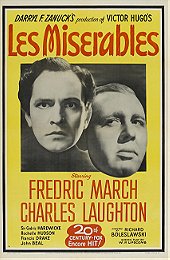This 1935 adaptation of Victor Hugo’s novel jettisons much of the supporting players and extended sub-plots to zero in on the complex battle of wills between Inspector Javert and Jean Valjean. This gives two actors a chance to strut their stuff, even if it does leave the film with a sense of being incomplete.
The production values are high in this film though. And it is money well spent, everything looks positively gorgeous. Cinematographer Gregg Toland flexes all of his muscle in this film, not in a way that is needlessly show-offy, but one that strengthens the emotions going on underneath the story and creates a series of beautiful images to get lost in. But Toland is only one-third of the triad that makes this version of Les Miserables so successful.
The other two belong to leading actors Fredric March and Charles Laughton. Granted, Valjean is a bit of a saintly man-on-the-run if not played correctly, but March won two Oscars and several Tonys during his lifetime for a reason. He makes his Valjean feel desperate at times, even searing with barely concealed rage, finding the right moments to underplay and hit us with the devastating twists and turns of the story. As for Laughton, was there a better actor at playing immensely watchable villains during the 1930s? Laughton’s impertinent baby-face could easily be read in different forms of theatrical villainy, from the sexual other in Island of Lost Souls to his mad Bligh in Mutiny on the Bounty, and here he makes the obsession of Javert understandable, even occasionally sympathetic.
And so much of the success of Les Miserables can be squarely placed on their shoulders. No other actor makes much of an impression, frankly, none of them have a chance. Fantine is barely a cameo, Cosette is a plot device and not a character, Eponine and Marius show up, but that’s about all that can be said for them. So much of the story has been removed to focus on the surface level cat-and-mouse game between the two leading men. It’s a quick skimming of the material, missing out on the deeper resonances and world-building of Hugo’s novel. As Hugo it’s terrible, but as an independent entity, it’s a pretty solid prestige film from the 30s with two fantastic leading performances and gorgeous cinematography.
 Login
Login